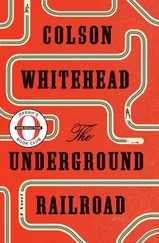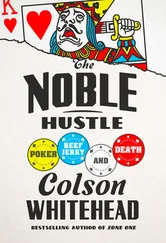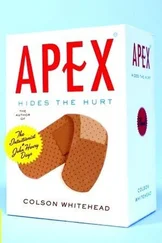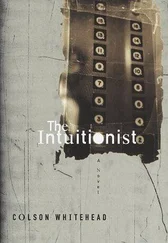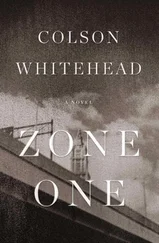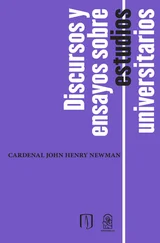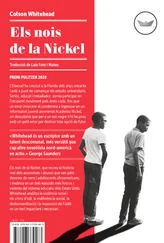He turns around and finds himself in front of soft stacks of John Henry T-shirts. He recognizes the design as a black-and-white copy of the stamp.
The image is a little hard to make out because it has not been well reproduced, the grays aren’t that forceful, and John Henry is very black, like a smudge almost. He can almost make out the mouth and chin, but for the most part the face is just dark. What expression is there is anyone’s guess. Past the right shoulder of John Henry a locomotive speeds into futurity. The business end of his sledge rests on his shoulder. Alphonse thinks the hammer looks in pretty good condition, pristine, as if it’s never been used.
Everybody’s wearing one. They sell like hotcakes. The owner’s young son handles all the transactions while his father chats with a crony and the boy is meticulous with the change, counting aloud.
Alphonse puts the T-shirt on over his red polo shirt, tugging the collar out over the neck of the T-shirt. The black church sells plates piled heavy from heated aluminum trays. Do they still call it soul food, or have they changed that too, Alphonse wonders. In the sensitivity seminar at work the consultant they hired said that any word out of the mouth can be a ticking timebomb. He hears, “Lost child Kevin Graham is at the information booth. Lost child Kevin Graham is at the information booth. His mother’s name is Carol.” Then the siren blows and everyone stops in their tracks. The train is coming.
The fairgrounds are adjacent to the tracks, separated from the fair by steel fencing and frowning rent-a-cops. It might be a special day for the town of Talcott, but the business of CXS Transportation must continue. Alphonse, denizen of middle management, understands this. The crowd charges over to the railward part of the grounds to jockey and jostle by the fence. There’s a slim space between there and the last row of booths, and the people squeeze in. Alphonse finds a place in the second row, behind a father balancing a daughter on his shoulder. The guards tell everyone to take it easy, hold on, don’t lean on the fence. Most of them are teenagers and wish they had a gun to go with the uniform. Instead they have to rely on tough guy stares honed over time in convenience store parking lots. Everyone looks away from the mountain. East toward the coming, crawling train.
Hey.
The general readership magazine that recommended stamp collection as a worthwhile hobby advised that choosing one kind of stamp, a specialty, might add shape and purpose. Before he caught on Alphonse collected only those stamps that arrived on his correspondence. He cut out the corner of the envelope and soaked it in warm water. Once the stamp loosed, he removed it gingerly with the tongs that came in the mail order stamp collecting kit, and dried it overnight in a paper towel. The next day he slid the stamp in the hinge and deliberated, directed by personal symmetry, over its place in the album. After a few months he had many stamps, to be sure, an index of received confidences and dull immediacies, but there was no order to them. It was a collection of randomness he had preserved there, and looking over what he had assembled depressed him. Surely this was not what a hobby was supposed to be. Hobbies made the days easier, what, they knocked down imposing hours into moments that stretch. Then he went to his first stamp fair, at the convention center. He walked up and down the rows. Everyone was so serious and seemed to know what they were doing. Even the little kids knew what they were looking for, going up to dealers to ask if they had NASA space stamps or reptiles. He tried to look busy; everyone knew he didn’t belong there, surely, he felt it on his neck in pore-squeezed sweat. He busied himself in a dealer’s penny box, where they put all the dregs that no one wants, that have no value, where everything goes for a penny no matter what the postage declares. He picked through Thomas Edison, Dutch tulips, a number of South American military dictators. Sweat stained his collar; everyone was looking at him. Then he found his first railroad stamp.
It was a commemorative for the first trip of the Atlanta Zephyr. Was he supposed to recognize the Atlanta Zephyr? Was it famous and he was out of the loop or was the line something lost and his ignorance the common and most appropriate response to the name of the old Georgia train? A nibble off the top left edge was missing, and half the perforations were gone. But — he couldn’t stop his finger from running over its rough skin. He could feel the speed. The image fell into what he would later discover to be the standard portrayal of trains on stamps: a locomotive and a car or two speeding off the right edge with a little puff of steam, foreshortened to suggest departure from an old world and speed across the border into the new. It was not a picture of a vase or a cat. The train, tinted blue, was a notion of possibility. Human beings had made these trains, men like him, and if to outsiders a stamp was no kind of monument to a grand idea, for Alphonse this was true craftsmanship. With a few simple strokes, with a few anonymous cars and one noble locomotive, the artist had composed the definition of dreaming. Anything could be in those cars, anything he wanted. Off the border, nameless destinations that all who boarded knew as Paradise. Inside, special people bound for safety, the saved and the blessed, and what kind of freight in the boxy cars? Gold or the smart man’s invention or penicillin for the epidemic. News of the peace treaty. Once his collection started in earnest, he’d spend hours with a magnifying glass trying to discern human faces in the passenger cars, with such enthusiasm his posture degraded to its present stoop. He placed his face behind those sooted windows and willed himself safe passage.
Now he can log on the internet and trade information through his phone line, but in those early days he haunted catalogs and newsletters, discovering that every specialty had its society, and they communicated through a secret language. He mailed a five-dollar money order and received a F/VF commemorative of the Gold Rush Centennial, sent another for six seventy-five and got General Motors’ Train of Tomorrow, with its optimistic jet age angles. Sometimes when the illustrations were uninteresting, falling into the standard locomotive/car profile, the titles were enough to trigger enthusiasm. The Florida Sunbeam Is Coming Back — he didn’t know the history, what tragedy had befallen the Florida line that made its return such a glorious event, but his blood rushed. The First Winter Run of the Georgia Mercury, M condition. He read the words Alaska Railroad, 25 Years of Progress (F/G) and saw crews hacking ice in the tundra, a few sled dogs dozing by the fire and a new settlement just over the next hill that needed supplies by rail. Progress, progress in limited issues, warmed him and justified his days. The Inaugural Daily Service Chi-LA El Capitan (NM) described to him a nation learning to run; daily service across half the country was civilization. Even the mundane issues — the solemn Helsinki Railway Station (VG), the humble First Diesel (G) in Bangladesh, Bulgaria’s Unloading Mail Car (F), the commemorative for unsung hero Andel Pinto, Railway Builder (NM) of Brazil — were like press releases from the office of the twentieth century, from his basement view, informing the citizens of the world that each new peak bested was mere appetizer to the next novel summit just now in view. He filled albums and albums with stamps from around the world. Every place on the globe was linked by the invention of the railroad, it crossed oceans and cultures.
He didn’t notice when he started collecting the stamps of dead places. The Last Run of the Sante Fe Motor (P), Commemorating the End of Old Erie (G), Old Brighton Terminal (NM). They issued stamps for dead lines, defunct lines, extinct depots. Routes that had become obsolete, replaced by superhighways or snipped short by politics. Towns failed, everybody moved away and the terminal shut its doors in anticipation of vandalism, became a stamp. Small independent lines were bought up and swallowed by larger ones. Tracks uprooted to be melted down into arms for the revolution, or left to weed over. Impractical lines laid out of vanity that never justified the planning of the right of way. Top of the line locomotives made inefficient by technical advances. What remained of the ultimate in human achievement was a stamp. It was all obsolete and preserved in adhesive elegies, limited-issue testament. He collected it all.
Читать дальше
Конец ознакомительного отрывка
Купить книгу

